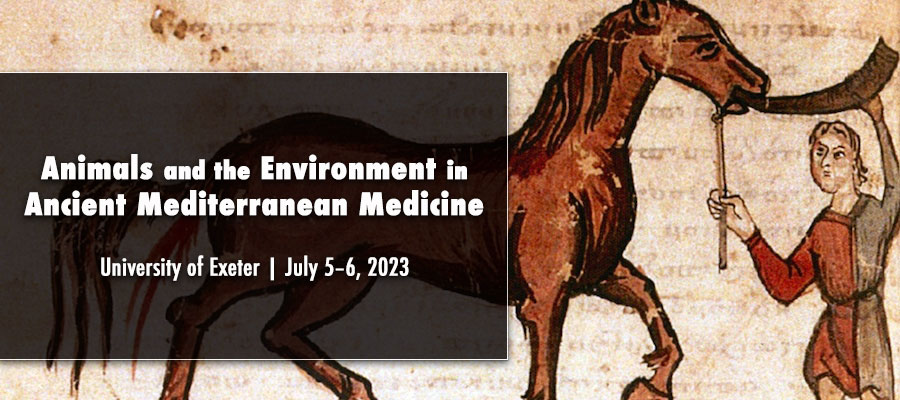Animals and the Environment in Ancient Mediterranean Medicine, University of Exeter, July 5–6, 2023
This conference will explore animals as both objects of ancient medical and scientific endeavour and as subjects in their own right within their wider environmental context. It responds to recent calls for sustained dialogue between medical history (human and veterinary) and the burgeoning field of human-animal history (e.g. Woods et al., 2018; Woods, 2019). Classical studies have broadly embraced the animal turn but with little focus on medicine so far (though see e.g. Thumiger, 2021; Boehm and Luccioni (eds.), 2008). The aim here is to develop a richer, more wide-ranging account of animals within the ancient history of human/veterinary medicine alongside, and in conversation with, similar developments for later historical periods, and to reflect on the connections drawn in antiquity between humans, animals, and their environment, from a perspective of health, disease and wider well-being.
Much of the ancient medical attention paid to animals was essentially instrumental, in support of their vital roles in agriculture, warfare, hunting and other areas of human life. Medicine made extensive therapeutic use of a diverse set of animal products on its own account and exploited animal bodies for other purposes too. All these activities relied on assumptions that all living things were shaped by the same environmental and cosmic forces, able to interact on that basis, while also being differentially located in networks of value and meaning. Animals were always good to think with—comparatively, imaginatively, ethically—and good for constituting and challenging hierarchies. The lives and experiences of animals in the ancient Mediterranean world, their bodies and relationships, were all affected by these human actions and ideas, by medical practice and theory, but it is important to stress that animals were not just shaped by human/veterinary medicine, they also shaped it. Their behaviours and materialities, their ability to spread diseases to humans and to be a particular form of patient, and cure, all contributed to the production of the medical art. Taking an environmentally situated interspecies approach to ancient medical knowledge and medical interventions promises new insights across a range of themes and problems.
Abstracts are invited from scholars at any stage in their academic career, including PhD students, for papers that address any aspect of the topic. Some important themes include, but are by no means limited to:
- Animals and disease: are there patterns to the ailments livestock shared with humans and those which were more specific? What is to be made of the plagues recorded in the historical sources as involving humans and cattle? What about other animals in epidemics? While notions of contagion seem more developed in herds and flocks than human populations (see Nutton, 2000), it is perhaps only hydrophobia and worms that were conceived as human diseases caused by animals, though poisonous bites and stings should perhaps also count. How did all these aetiologies work? What about illnesses named after or imagined as animals?
- Animals as patients: livestock were mostly treated collectively, and by command, according to models more or less explicitly contrasting with ideals of individualised and actively participatory human medicine, at least for the free male elite. How far was this distinction blurred, by the methodic sect in Rome or in valetudinaria for the enslaved, or can cases of the individual treatment of animals, perhaps horses or favoured hunting dogs, be found? To what extent did generation and gendering divide the animal collective? What can osteological (and other material) evidence contribute on these issues?
- Animals as therapy: both familiar and more exotic animals feature in ancient therapeutic repertoires, in whole and in part, and in various explanatory (or non-explanatory) frames. What sort of choices were made, and emphasised in these respects? Do animal products interact with humans in roughly the same or different ways than plants and other medicinal items? Are they differently described and specified? What about animal on animal cures? Were there particular animal therapeutics? Is there an archaeology of animal therapeutics?
